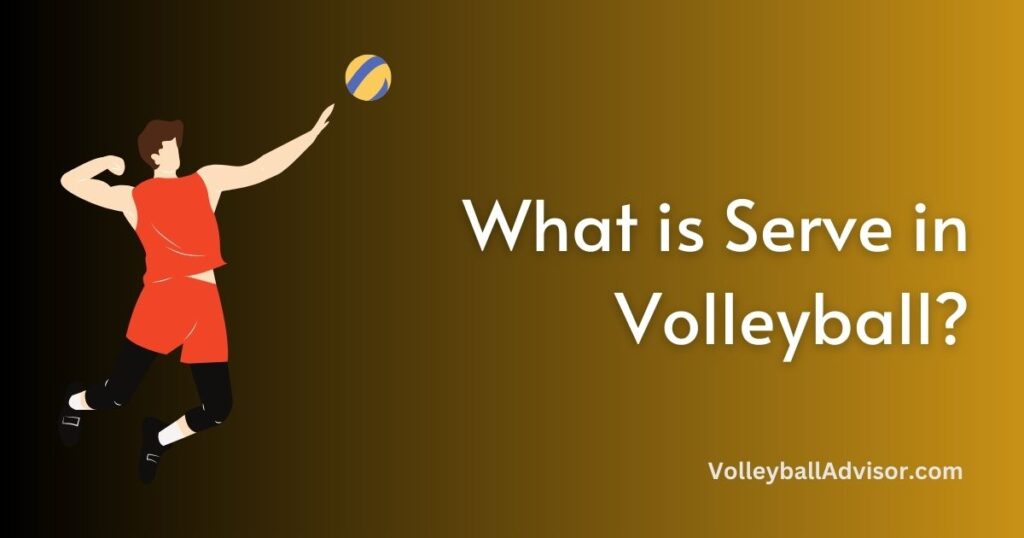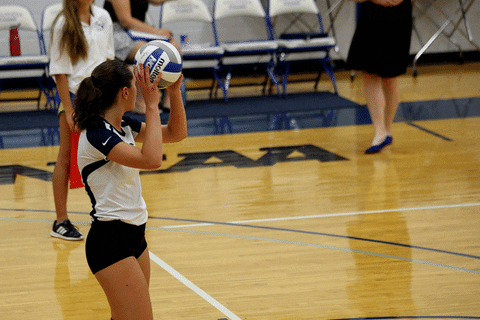The serve is a critical aspect of volleyball as it initiates the rally and sets the tone for the entire play.
A strong serve can give a team a significant advantage by disrupting the opponent’s offensive strategy, targeting specific players, and creating scoring opportunities.
Additionally, the serve allows players to showcase their skills and technique, making it a vital component of a well-rounded volleyball player’s repertoire.

This article aims to provide an in-depth analysis of the serve in volleyball, exploring the different types of serves, serving strategies, and the importance of serve reception and defense.
It will also discuss techniques for improving serving skills, rules, regulations related to serving, and the role of serving at different levels of play.
By understanding the intricacies of the serve, players, and enthusiasts can gain a deeper appreciation for the sport and develop the necessary skills to elevate their performance on the court.
What is Serve In Volleyball
In volleyball, a serve is an act of initiating a rally by striking the ball with one hand or any part of the arm, sending it over the net and into the opponent’s court from behind the service line. The serve sets the ball into play and is a crucial skill in determining the course of a point.

Types of Serves
Underhand serve
The underhand serve is a beginner-friendly serve where the player strikes the ball with an underhand motion while keeping the arm straight. It is often used by novice players or in recreational games.
How To Perform?
To execute an underhand serve, stand with feet shoulder-width apart, slightly bend your knees, and hold the ball in your non-dominant hand at waist level.
Swing your dominant arm back, and then forward in a smooth underhand motion, striking the lower part of the ball with the heel of your hand.
Advantages and disadvantages
The underhand serve is easier to learn and control, making it suitable for beginners.
However, it lacks speed and power, making it easier for opponents to receive and counter.
Overhand serve
The overhand serve, also known as the tennis serve, is a more advanced serving technique where the player tosses the ball and hits it with an overhand motion, generating more power and speed.
How To Perform?
Stand with feet staggered and knees slightly bent, facing the target area. Hold the ball in your non-dominant hand, extend your dominant arm back, and toss the ball upward. As the ball reaches its highest point, swing your dominant arm forward, striking the ball with an open hand and following through.
Advantages and disadvantages:
The overhand serve provides more power and speed than the underhand serve, making it more challenging for opponents to receive. However, it requires greater skill and practice to execute consistently and accurately.
Jump serve
The jump serve is an aggressive, high-level serving technique that combines the power of an overhand serve with the added momentum of a jump, generating even more speed and force.
How To Perform?
Begin with a few steps behind the service line. Perform a three-step approach, tossing the ball high into the air as you take the last step. Jump off both feet, swinging your dominant arm forward, and striking the ball at the highest point of your jump with an open hand.
Advantages and disadvantages
The jump serve is a powerful and intimidating weapon, capable of generating high-speed serves that can catch opponents off guard.
However, it requires exceptional timing, coordination, and athleticism, making it more challenging to execute consistently.
Additionally, it can be more prone to errors, such as foot faults or missed serves.
Float serve
The float serve is a type of overhand serve that generates little or no spin on the ball, causing it to move unpredictably in the air, similar to a knuckleball in baseball.
How To Perform?
Stand with feet staggered and knees slightly bent, facing the target area. Hold the ball in your non-dominant hand and toss it upward. Strike the ball with a flat, open hand in the center or slightly below the center, minimizing wrist snap to reduce spin. Follow through with a controlled motion.
Advantages and disadvantages:
The float serve is deceptive and challenging for opponents to receive due to its unpredictable movement.
However, it lacks the speed and power of other serves, making it less effective against skilled receivers.
Topspin serve
The topspin serve is an advanced overhand serve that imparts significant topspin on the ball, causing it to dive sharply as it crosses the net.
How To Perform
Stand with feet staggered and knees slightly bent, facing the target area.
Hold the ball in your non-dominant hand and toss it upward and slightly in front of you.
As the ball reaches its highest point, snap your wrist and strike the upper part of the ball with an open hand, generating topspin. Follow through with your arm, ensuring a smooth and fluid motion.
Advantages and disadvantages
The topspin serve can be highly effective due to its sharp downward trajectory, making it difficult for opponents to receive.
However, it requires precise timing, accuracy, and mastery of the wrist snap to execute consistently.
Additionally, poorly executed topspin serves can result in easy points for the opposing team if they do not clear the net or land out of bounds.
Serving Strategy
A. Importance of strategic serving Strategic serving is crucial in volleyball as it can significantly impact the opposing team’s ability to execute their offense. By employing a well-thought-out serving strategy, a team can exploit weaknesses in the opponent’s formation, create scoring opportunities, and maintain control of the game.
B. Targeting specific players One effective serving strategy is to target specific players on the opposing team, particularly those who may struggle with serve reception or are less experienced. By consistently serving at these players, a team can increase the likelihood of errors, limit the opponent’s offensive options, and potentially force them to make lineup adjustments.
C. Disrupting the opponent’s offense Another important aspect of strategic serving is to disrupt the opponent’s offense by varying the type, speed, and location of serves. Mixing up serves can keep the opposing team guessing and prevent them from getting comfortable with a particular receiving pattern. This can lead to an increase in errors, forced passes, and less effective attacks.
D. Serving to create pressure Applying pressure on the opposing team through serving can lead to mental and physical fatigue, resulting in more mistakes and less effective plays. To create pressure, a server can use powerful serves, well-placed float serves, or exploit specific rotations that challenge the opponent’s formation. A team that can consistently serve with power and precision is more likely to control the pace of the game and dominate on the court.
Rules and Regulations for Serving
Basic serving rules
- The server must stand behind the service line while serving.
- The server has eight seconds from the referee’s whistle to initiate the serve.
- The server must contact the ball with one hand or any part of the arm.
- The ball must pass over the net and land within the opponent’s court for a successful serve.
Rotation and serving order
- Teams rotate clockwise after winning a point on their serve.
- Each player must serve in the same order throughout the set.
- A violation of the serving order results in a loss of serve and a point awarded to the opposing team.
Foot faults
- A foot fault occurs when the server’s foot crosses the service line or touches the court before the ball is contacted.
- A foot fault results in a loss of serve and a point awarded to the opposing team.
D. Let serves and illegal serves
- A let serve occurs when the ball contacts the net on a serve but still lands in the opponent’s court. In most volleyball variations, let serves are considered legal and play continues.
- Illegal serves include: a. Serving before the referee’s whistle. b. Serving out of order. c. Failing to serve within the eight-second time limit.
- An illegal serve results in a loss of serve and a point awarded to the opposing team.
Conclusion
In conclusion, serving is a crucial aspect of volleyball that sets the tone for each rally and can greatly influence the outcome of a match.
A strong, strategic serve can provide a team with a significant advantage by disrupting the opponent’s offensive strategy, targeting specific players, and creating scoring opportunities.
Mastering various types of serves, including underhand, overhand, jump, float, and topspin serves, can enhance a player’s skill set and contribute to their team’s overall success.

